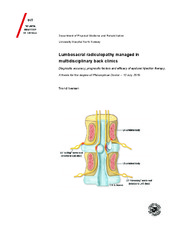Lumbosacral radiculopathy managed in multidisciplinary back clinics. Diagnostic accuracy, prognostic factors and efficacy of epidural injection therapy.
Permanent lenke
https://hdl.handle.net/10037/8547Åpne
Thesis introduction and appendices 4-7 (PDF)
Accuracy of physical examination for chronic lumbar radiculopathy. Iversen T. et al. Also available in BMC Musculoskeletal Disorders 2013, 14:206 (PDF)
Outcome prediction in chronic unilateral lumbar radiculopathy: prospective cohort study. Iversen T. et al. Also available in BMC Musculoskeletal Disorders 2015, 16:17 (PDF)
Effect of caudal epidural steroid or saline injection in chronic lumbar radiculopathy: multicentre, blinded, randomised controlled trial. Iversen T. et al. Also available in BMJ 2011 Sep 13;343:d5278 (PDF)
Thesis entire (PDF)
Dato
2015-10-27Type
Doctoral thesisDoktorgradsavhandling
Forfatter
Iversen, TrondSammendrag
The accuracy of individual clinical index tests used to predict imaging findings of nerve root impingement in patients with chronic lumbar radiculopathy is low when applied in specialized care, but clinicians’ overall evaluation improves diagnostic accuracy slightly. The diagnostic accuracy of individual index tests was low with no tests reaching positive LR >4.0 or negative LR <0.4. The overall clinical evaluation was slightly more accurate, with a positive LR of 6.28 (95% CI 1.06–37.21) for L4, 1.74 (95% CI 1.04–2.93) for L5, and 1.29 (95% CI 0.97–1.72) for S1 nerve root impingement. The tests are not very helpful in clarifying the cause of radicular pain, and are therefore inaccurate for guidance in the diagnostic workup of the patients.
Lower age, higher education, working full-time and low fear avoidance beliefs each predict a better outcome of chronic unilateral lumbar radiculopathy. Specifically, lower age and low fear avoidance predict a better functional outcome and less back pain, while higher education and working full-time predict less leg pain.
Treating chronic lumbar radiculopathy with either caudal epidural steroid injections or epidural saline cannot be recommended. Compared to a sham procedure, we found no evidence of any clinically important treatment effect of caudal epidural steroid or saline injections in patients with chronic lumbar radiculopathy. The differences in outcome for the epidural saline intervention group compared to the sham intervention group were −0.5 (−6.3, 5.4) at the 6-week follow-up, 1.4 (−4.5, 7.2) at the 12-week follow-up, and −1.9 (−8.0, 4.3) at the 52-week follow-up. The differences in outcome for the epidural steroid intervention group compared to the sham intervention group were −2.9 (−8.7, 3.0) at the 6-week follow-up, 4.0 (−1.9, 9.9) at the 12-week follow-up, and 1.9 (−4.2, 8.0) at the 52-week follow-up.
Forlag
UiT The Arctic University of NorwayUiT Norges arktiske universitet
Metadata
Vis full innførselSamlinger
Copyright 2015 The Author(s)
Følgende lisensfil er knyttet til denne innførselen:


 English
English norsk
norsk
